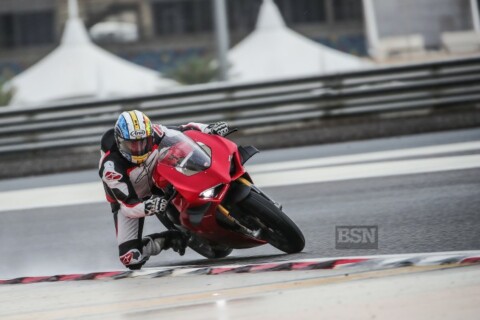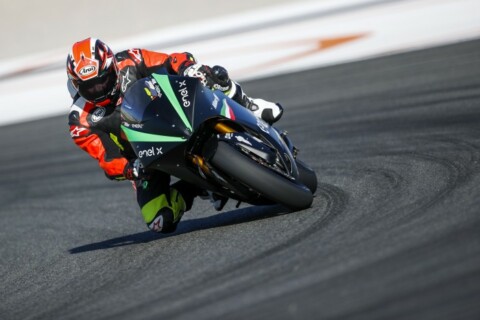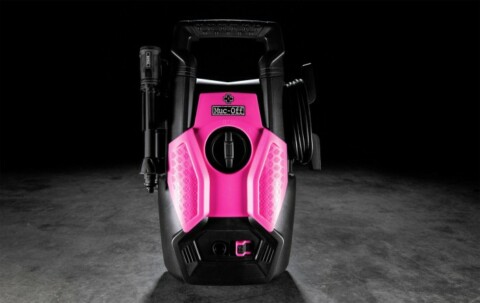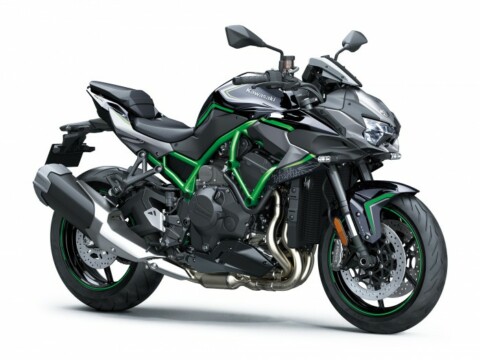Yamaha’s 2018 R1M has the most advanced electronic ‘brain’ fitted on any production motorcycle. The same technology, Ohlins say, as you’ll find on Rossi’s MotoGP bike and better than that found on Josh Brookes’ British Superbike Championship R1.
These are big claims and ones we’ve heard all-to often before – ‘MotoGP-inspired’ is a well-worn manufacturer marketing path to tempt sportsbike buyers into thinking their bike is a race-developed thoroughbred. Too often it’s either a false promise or at least such a water-down version you can’t feel the link.
Apart from a slightly different colour lower fairing, changes to the 2018 Yamaha R1M aren’t immediately clear and you’d be excused for thinking this was another bike bluffing the truth. But under that fairing lies the key to perhaps the biggest step forward in motorcycle technology in decades.
Ohlins have worked closely with Yamaha on R1M’s the inertial measurement unit (IMU) to make a big step forward for the 2018 model in adapting the “next generation smart control unit” – the Ohlins Smart EC 2 ERS – from MotoGP bikes straight across to the R1M.
What’s the big technological change all about? Basically how much information is gathered and adjusted while you ride. Taking data from the R1M’s 12 sensors around the bike (was nine on the previous model) the IMU is taking readings and analysing 100 times every second. This isn’t ‘MotoGP-inspired’, more MotoGP-adapted.
The new system is adjusting as you ride looking at and adjusting five separate “events” in every corner (was three): Braking, mid-corner slip control, acceleration, front and rear firmness. Rather than reading and adapting itself based on set parameters this system is controlling braking, power and suspension movement live as you ride.
The 2018 model also has an improved quick shift system (QSS), adding a downshifter using a blipper system. It means you can ride without using the clutch and (within reason) change down when you want and let the system sort things out.
Yamaha has improved the R1M’s lift control (LIF) too, which is not to be confused with an anti-wheelie system. It will wheelie under acceleration or over crests but LIF controls the lift subtly controlling the wheelie and drive forwards.
It is hard to trust the system and keep on the throttle as the wheel rises up nicely over one of Portimao’s crests or tight corners. When you do stop yourself rolling the throttle or dabbing the rear brake it is doing everything a MotoGP, WSBK or BSB bike is to propel you forward as fast as possible while curbing the front wheel.
LIF, like so many elements of this R1M’s electronic control is adjusted via the Yamaha Ride Control (YRC) function on the full colour TFT instrument panel. It’s simple and comprehensive to use. LIF, the suspension settings, power delivery, amount of power, slip control, ABS braking plus suspension stiffness and more is quickly and easily set to suit your preference or track conditions.
If it sounds like too much, like a nanny-state controlling your every move, well it is and it isn’t. It is controlling your every move but in the same way Rossi’s bike is controlling his every move. Would you be better off with all this turned off? Not a chance. Can you imagine how much slower Rossi would be without the electronics? For mortals like the rest of us it is only ever going to make you a faster rider. Besides, I tried it for a few laps with full power and minimal electronic input and it was a bloody nightmare.
What seemed like a barely changed bike on paper actually turned out to be distinctly updated. Easily a rival for Ducati’s recently launched Panigale V4, the 2018 Yamaha R1M works, as you’d expect, it all works very well indeed. The idea of race-replica sportsbike has reached the next level with genuine MotoGP derived electronics package.
On-board the R1M with Michael van der Mark
GYTR Kit bike tested
If the 2018 R1M wasn’t enough Yamaha also laid on a race bike to test for a 25mins session round Portimao. With two choices (SBK or superstock spec) there was no choice – the superbike please.
Yamaha’s newly monikered Genuine Yamaha Technology Racing (GYTR) race parts catalogue – it’s a biggy – has been successfully developed behind the scenes for years. Formerly called YEC, the dealer supplied race parts catalogue is no secret to riders at national level road and short circuit races.
For “around 40 or 50 thousand Euros” you can get yourself a superbike-spec R1 according to YART Yamaha World Endurance race team manager Mandy Kainz. He should know, YART build around 100 every year to send around the world.
Though a healthy chunk different in spec from the Pata Yamaha WSBK bikes (though Paul Denning say they run the same, standard main frame) the GYTR kit bike runs a decent list of engine internals to hoik the stock R1M engine’s power to 15bhp or so short of what most superbike race teams would run. A very similar spec to that which Josh Brookes is running in BSB or Broc Parkes ran for a one-off WSBK ride at Phillip Island in 2017. See the spec list below.
In fact it has one over on the BSB bikes because it has traction and wheelie control. With race kit wiring loom and ECU it is still using the same electronics package as the R1M so can be dialled to a greater degree, closer to WSBK bike.
It is a pretty damn impressive bike. Where the R1M is a brilliant track bike which you could race in stock 1000s, this is a pure race bike – too tuned for 24hr endurance racing according to Kainz and it felt it. Suddenly life around Portimao got a whole lot more lively with a set-up more on its nose, wider clip-ons and better positioned footrests it was serious attack mode.
Gone is the electronically controlled suspension and in its place the ‘conventional’ and sublime Ohlins FKR 103 forks and TTX GP rear shock. Set-up by Yamaha’s test riders it was more lively heading into corners than the R1M but a lot of that is down to the sheer braking force.
Ballistic braking performance from the Brembo GP4RX calipers with Brembo Z04 race pads and 19 RCS forged master cylinder is boosted by the downshift control blipping the throttle for me.
Shut the throttle, brake hard, hold on and the bike does the rest. Turn-in and mid corner is a test of trust in the Bridgestone V02 slick tyres but way more of a test of holding on under extreme forces. This bike grips, turns and accelerates with such force it is incredible.
Out the corners it is an awesome handful of power. With closer ratio gearing and power for miles the get-up-and-go is a force of nature trying to push you up and off the track – I find myself climbing all over the footrests to keep on lines and having to be more alert with my body to make it work. Quickly it is a lesson in why superbike racers are so skilled and so fit to control all this so consistently at the limit during a race.
A little under a decade ago I rode Ben Spies’ WSBK championship winning R1 round Portimao and I can honestly say the stock 2018 R1M feels better than that – let alone the GYTR weapon. Times and tyres have changed of course but this electronics system is miles better than Spies’s R1. Racing improves the breed is surely true when MotoGP technology is jumping across like this to the bikes we can buy.
GYTR kit parts are available through the Yamaha dealer network. Go there. Now.
Yamaha operates a booking system for the R1M. 1000 in total will be made. Click here for more
Yamaha R1M Specs:
Engine: 998cc, FI, 4-stroke, liquid-cooled, DOHC, 16v, in-line four
Displacement: 998cc
Bore x stroke: 79.0mm x 50.9mm
Compression ratio: 13.0 : 1
Maximum power: 197.2bhp @ 13,500rpm (claimed)
Maximum torque: 83ft lb @ 11,500rpm (claimed)
Transmission: 6-speed, chain
Frame: cast aluminium diamond type
Caster angle: 24º
Trail: 102mm
Front suspension: Ohlins 43mm NIX30 forks, electronically controlled
Rear suspension: Ohlins TTX36 electronically controlled
Front brakes: twin Brembo four piston calipers, 320mm discs with cornering ABS
Rear brake: Brembo two piston caliper, 220mm disc
Front tyre: Bridgestone RS10 120/70 ZR17
Rear tyre: Bridgestone RS10 200/55 ZR17
Seat height: 860 mm
Wheel base: 1,405 mm
Wet weight: 201 kg (claimed)
Fuel tank capacity: 17 litres
GYTR bike highlights:
GYTR ECU and wiring harness
GYTR Piston set/Conrod set/Crank/Camshafts/Valve spring set
GYTR Air funnel set
Race Radiator
GYTR CCU
GYTR quick throttle
Akrapovic EVO2 full titanium race exhaust
Öhlins R1M Front fork with FKR103 cartridge type
Öhlins TTX GP rear shock
Öhlins Steering damper
Brembo T-Drive 320mm discs
Brembo GP4RX Calipers with Z04 pads
Brembo 19 RSC master brake cylinder
Race handlebar switches
Gilles Tooling rear sets
Gilles Tooling engine & axle protection
Full carbon bodywork










